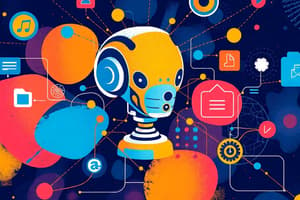Podcast
Questions and Answers
Which AI application is primarily used to provide personalized learning experiences by adapting to the individual student's pace and skill level?
Which AI application is primarily used to provide personalized learning experiences by adapting to the individual student's pace and skill level?
- AI-driven administrative tools
- AI-powered plagiarism checkers
- Automated grading systems
- AI tutors and chatbots (correct)
What is the primary purpose of using AI-driven tools for administrative tasks in educational institutions?
What is the primary purpose of using AI-driven tools for administrative tasks in educational institutions?
- To automate and streamline repetitive tasks, such as scheduling and data entry. (correct)
- To personalize learning content for each student.
- To create interactive simulations for science and mathematics classes.
- To provide immediate feedback to students on their assignments.
In what way do AI-powered writing tools assist students in improving their composition skills?
In what way do AI-powered writing tools assist students in improving their composition skills?
- By automatically generating complete essays based on provided prompts.
- By providing real-time translation of written text into multiple languages.
- By converting written text into audio format for students with learning disabilities.
- By offering suggestions for grammar, style, and clarity, as well as identifying potential plagiarism. (correct)
Which of the following describes how AI is used in automated grading systems?
Which of the following describes how AI is used in automated grading systems?
How can AI enhance accessibility for students with disabilities in educational settings?
How can AI enhance accessibility for students with disabilities in educational settings?
What is a potential limitation of relying heavily on AI-driven personalized learning systems?
What is a potential limitation of relying heavily on AI-driven personalized learning systems?
How might AI algorithms in education contribute to biased learning experiences?
How might AI algorithms in education contribute to biased learning experiences?
In what way could AI-driven tools support curriculum development and design?
In what way could AI-driven tools support curriculum development and design?
How might educational institutions address ethical concerns related to data privacy when implementing AI technologies?
How might educational institutions address ethical concerns related to data privacy when implementing AI technologies?
What is the role of educators in the age of AI-driven education?
What is the role of educators in the age of AI-driven education?
Which of the following is an example of how AI can support language learning?
Which of the following is an example of how AI can support language learning?
How can AI be used to personalize learning for students with diverse learning styles?
How can AI be used to personalize learning for students with diverse learning styles?
What is the benefit of using AI to automate administrative tasks in education?
What is the benefit of using AI to automate administrative tasks in education?
How can AI assist special education teachers in supporting students with disabilities?
How can AI assist special education teachers in supporting students with disabilities?
What role does AI play in improving the efficiency of grading and assessment in education?
What role does AI play in improving the efficiency of grading and assessment in education?
What is the potential impact of AI on student creativity and critical thinking skills?
What is the potential impact of AI on student creativity and critical thinking skills?
How can AI help bridge the achievement gap in education?
How can AI help bridge the achievement gap in education?
What is one way AI can assist in creating more inclusive learning environments?
What is one way AI can assist in creating more inclusive learning environments?
How can AI be used to predict student performance and identify at-risk students?
How can AI be used to predict student performance and identify at-risk students?
What is the role of data privacy and security in AI implementation within educational settings?
What is the role of data privacy and security in AI implementation within educational settings?
Flashcards
AI applications in education
AI applications in education
AI is used for personalized learning, automated grading, and providing intelligent tutoring systems.
Study Notes
- AI đang được ứng dụng rộng rãi trong giáo dục, từ việc cá nhân hóa trải nghiệm học tập đến tự động hóa các tác vụ hành chính.
Các ứng dụng chính của AI trong giáo dục:
- Hệ thống học tập thích ứng (Adaptive Learning Systems):
- Phân tích dữ liệu về hiệu suất của học sinh để điều chỉnh nội dung và tốc độ học tập phù hợp với từng cá nhân.
- Cung cấp các bài tập và tài liệu bổ sung dựa trên những lĩnh vực mà học sinh còn yếu.
- Giúp học sinh học tập hiệu quả hơn bằng cách tập trung vào những nhu cầu cụ thể của họ.
- Chatbots và trợ lý ảo:
- Trả lời các câu hỏi thường gặp của học sinh và phụ huynh về các vấn đề như thời khóa biểu, bài tập về nhà, hoặc thông tin về trường học.
- Cung cấp hỗ trợ kỹ thuật cho các nền tảng học tập trực tuyến.
- Giải phóng thời gian của giáo viên để họ có thể tập trung vào việc giảng dạy và tương tác trực tiếp với học sinh.
- Công cụ chấm điểm và phản hồi tự động:
- Tự động chấm điểm các bài kiểm tra trắc nghiệm, bài luận và các bài tập khác.
- Cung cấp phản hồi tức thì cho học sinh về những lỗi sai của họ.
- Giúp giáo viên tiết kiệm thời gian chấm bài và cung cấp phản hồi nhanh chóng cho học sinh.
- Phần mềm phát hiện đạo văn:
- Sử dụng AI để phát hiện đạo văn trong các bài luận và bài tập của học sinh.
- Giúp duy trì tính trung thực trong học tập và khuyến khích học sinh tự suy nghĩ và viết bài.
- Công cụ hỗ trợ học ngôn ngữ:
- Cung cấp các bài tập luyện tập phát âm, ngữ pháp và từ vựng được cá nhân hóa.
- Sử dụng AI để đánh giá khả năng ngôn ngữ của học sinh và cung cấp phản hồi chi tiết.
- Giúp học sinh học ngôn ngữ một cách hiệu quả và thú vị hơn.
- Tạo nội dung giáo dục:
- Tạo ra các bài giảng video, bài tập tương tác và các tài liệu học tập khác một cách nhanh chóng và hiệu quả.
- Cá nhân hóa nội dung giáo dục cho phù hợp với nhu cầu của từng học sinh.
- Phân tích dự đoán:
- Dự đoán khả năng thành công của học sinh trong các khóa học hoặc kỳ thi.
- Xác định những học sinh có nguy cơ bỏ học và cung cấp hỗ trợ kịp thời.
- Giúp các trường học và tổ chức giáo dục đưa ra các quyết định sáng suốt hơn về việc phân bổ nguồn lực và hỗ trợ học sinh.
Ví dụ cụ thể về các ứng dụng AI phổ biến:
- Duolingo: Ứng dụng học ngôn ngữ sử dụng AI để cá nhân hóa các bài học và cung cấp phản hồi cho người học.
- Khan Academy: Sử dụng AI để cung cấp các bài tập và tài liệu bổ sung cho học sinh dựa trên hiệu suất của họ.
- Gradescope: Công cụ chấm điểm bài tập sử dụng AI để tự động chấm điểm các câu trả lời và cung cấp phản hồi cho học sinh.
- Turnitin: Phần mềm phát hiện đạo văn sử dụng AI để so sánh bài viết của học sinh với hàng tỷ trang web và tài liệu khác.
- Third Space Learning: Cung cấp các buổi dạy kèm toán trực tuyến sử dụng AI để cá nhân hóa các bài học và theo dõi tiến trình của học sinh.
Lưu ý:
- Sự phát triển và ứng dụng của AI trong giáo dục vẫn đang tiếp tục.
- Cần xem xét các vấn đề về đạo đức và tính công bằng khi sử dụng AI trong giáo dục.
- Cần đảm bảo rằng AI được sử dụng để hỗ trợ giáo viên và học sinh, chứ không phải để thay thế họ.
Studying That Suits You
Use AI to generate personalized quizzes and flashcards to suit your learning preferences.




